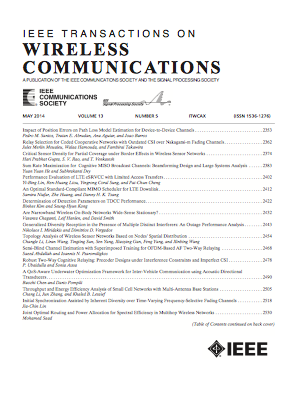智能反射面辅助多用户通信:传输分集与主动/被动编码的协同设计
IF 10.7
1区 计算机科学
Q1 ENGINEERING, ELECTRICAL & ELECTRONIC
引用次数: 0
摘要
智能反射面(IRS)已成为构建智能自适应无线电环境的一种经济有效的解决方案。以往关于 IRS 的大多数研究都是基于完全或部分已知的信道状态信息(CSI)来联合设计主动和被动预编码的。然而,在延迟敏感或高移动性通信中,必须探索更有效的方法来利用 IRS 增强通信可靠性,而无需任何 CSI。在本文中,我们研究了一种创新的 IRS 辅助多用户通信系统,该系统集成了 IRS 及其辅助多天线基站(BS),通过发射分集同时为多个高移动性用户提供服务,通过主动/被动预编码同时为多个低移动性用户提供服务。具体来说,我们首先揭示了当动态调整 IRS 与所有反射元件共享的共同相移时,其对任何低移动性用户的被动预编码增益保持不变。受这一特性的启发,我们利用 IRS 的共相移设计来实现传输分集,为高移动性用户提供服务,而无需在 BS 上提供任何 CSI。同时,将主动/被动预编码设计纳入集成 IRS 的 BS,为低移动性用户提供服务(假设 CSI 已知)。然后,考虑到不同用户之间的干扰,我们提出并解决了 IRS 的反射预编码和 BS 的发射预编码的联合优化问题,目的是使 BS 的总发射功率最小。仿真结果表明,在 IRS 辅助多用户系统中,我们所提出的发射分集和主动/被动预编码的协同设计与其他基准相比,可以实现更优越、更理想的性能。本文章由计算机程序翻译,如有差异,请以英文原文为准。
Intelligent Reflecting Surface-Aided Multiuser Communication: Co-Design of Transmit Diversity and Active/Passive Precoding
Intelligent reflecting surface (IRS) has become a cost-effective solution for constructing a smart and adaptive radio environment. Most previous works on IRS have jointly designed the active and passive precoding based on perfectly or partially known channel state information (CSI). However, in delay-sensitive or high-mobility communications, it is imperative to explore more effective methods for leveraging IRS to enhance communication reliability without the need for any CSI. In this paper, we investigate an innovative IRS-aided multiuser communication system, which integrates an IRS with its aided multi-antenna base station (BS) to simultaneously serve multiple high-mobility users through transmit diversity and multiple low-mobility users through active/passive precoding. In specific, we first reveal that when dynamically tuning the IRS’s common phase-shift shared with all reflecting elements, its passive precoding gain to any low-mobility user remains unchanged. Inspired by this property, we utilize the design of common phase-shift at the IRS for achieving transmit diversity to serve high-mobility users, yet without requiring any CSI at the BS. Meanwhile, the active/passive precoding design is incorporated into the IRS-integrated BS to serve low-mobility users (assuming the CSI is known). Then, taking into account the interference among different users, we formulate and solve a joint optimization problem of the IRS’s reflect precoding and the BS’s transmit precoding, with the aim of minimizing the total transmit power at the BS. Simulation results demonstrate that our proposed co-design of transmit diversity and active/passive precoding in IRS-aided multiuser systems can achieve superior and desirable performance compared to other benchmarks.
求助全文
通过发布文献求助,成功后即可免费获取论文全文。
去求助
来源期刊
CiteScore
18.60
自引率
10.60%
发文量
708
审稿时长
5.6 months
期刊介绍:
The IEEE Transactions on Wireless Communications is a prestigious publication that showcases cutting-edge advancements in wireless communications. It welcomes both theoretical and practical contributions in various areas. The scope of the Transactions encompasses a wide range of topics, including modulation and coding, detection and estimation, propagation and channel characterization, and diversity techniques. The journal also emphasizes the physical and link layer communication aspects of network architectures and protocols.
The journal is open to papers on specific topics or non-traditional topics related to specific application areas. This includes simulation tools and methodologies, orthogonal frequency division multiplexing, MIMO systems, and wireless over optical technologies.
Overall, the IEEE Transactions on Wireless Communications serves as a platform for high-quality manuscripts that push the boundaries of wireless communications and contribute to advancements in the field.

 求助内容:
求助内容: 应助结果提醒方式:
应助结果提醒方式:


